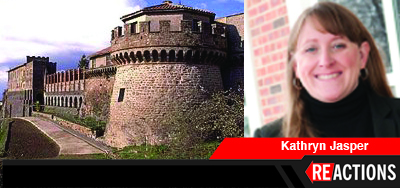Pope Francis recently canonized the first-ever Sri Lankan saint, 17th century priest Joseph Vaz. Assistant Professor of History Kathryn Jasper, who specializes in Medieval history, takes a look at how the process of sainthood has changed, and one example of sainthood going to the dogs – literally.
Jasper:
Back in the early days of Christianity, local bishops could proclaim someone a saint. Nothing had to be verified by the pope. Towns could essentially just erect monuments to local saints. This began to change around the 10th century, slowly moving the jurisdiction for declaring saints firmly into the hands of the pope
Members of the church made cases for trained theologians to be the decision makers for sainthood. One of the strongest – and probably the most fun – arguments came from Stephen of Bourbon in France. He was a Dominican inquisitor, traveling to find heretics. When he came to Lyon, he heard of the shrine of St. Guinefort, where locals took their children to receive blessings or be healed. He went there, expecting to see the depiction of an old, beloved member of the town. It turns out Guinefort was a dog.
The townspeople told Stephen the story that Guinefort lived in a castle and was the greyhound of a knight. When the family was away, a huge snake slithered its way into the baby’s room. Guinefort attacked the snake and killed it near the crib. Sadly, when the family returned, they saw blood on the crib and dog’s mouth and assumed Guinefort ate the baby. The knight drew his sword and slew the dog. Right after that, the baby cried, and they realized the truth. Filled with remorse, the knight built a shrine to the dog. Supposedly the castle was destroyed by an act of God, but the villagers rebuilt the shrine.
Stephen was not impressed, and he used this as an argument why the business of recognizing saints should fall under the authority of the Church. By the 13th century, the decision was wholly in the hands of the papacy.
Of course not all locally named saints are like Guinefort. Probably one of the best-known (and one of my favorite) saints is Catherine of Siena. Her work with the sick during the Black Death was respected even during her life, and there are arguments she held sway with Pope Gregory XI.
When the Church took over the business of saints, a system of bureaucracy stepped in, led by the Congregation of Causes of Saints in Rome. Candidates go from being a “servant of God” to being “Venerable,” then “Blessed” and finally to saint. The late Pope John Paul II even made it a bit easier to become a saint, dropping the need for a Promoter of Saints, or the person who played (no pun intended) devil’s advocate to the candidate’s case for canonization.
No matter who is named, the naming of saints is more political today than it was back then. In a lot of ways, you can think of it like the President naming a Supreme Court justice. That’s not to say they do not deserve it, but there is usually an agenda. Looking at Sri Lanka, you can see the Catholic Church is hoping to expand in that area.
You still – of course – need a miracle to make a saint. What’s changed it who decides what is a miracle.
Jasper can be reached through MediaRelations@Illinoisstate.edu.

